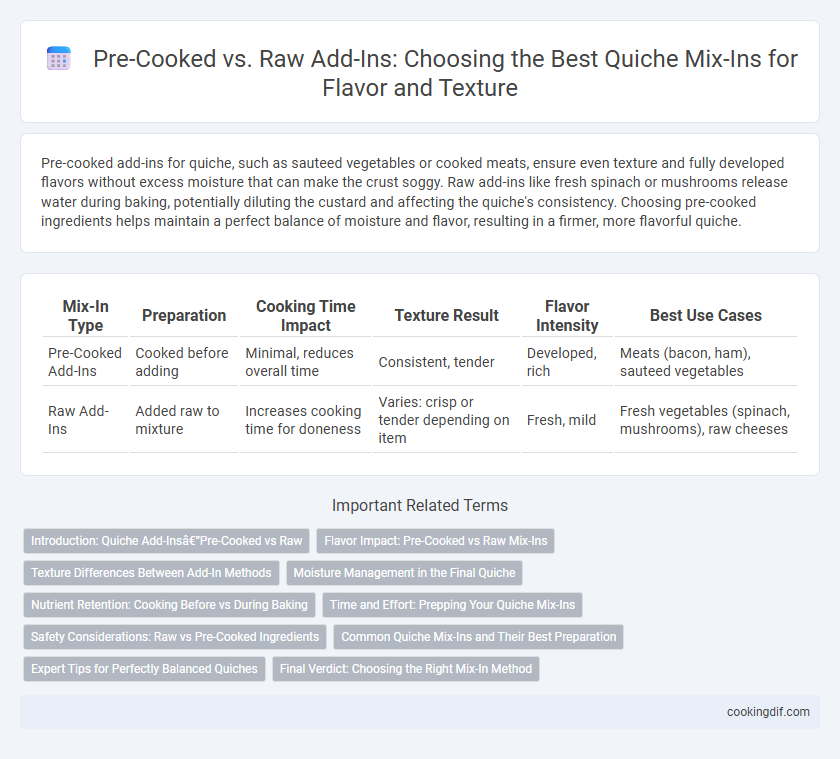Pre-cooked add-ins for quiche, such as sauteed vegetables or cooked meats, ensure even texture and fully developed flavors without excess moisture that can make the crust soggy. Raw add-ins like fresh spinach or mushrooms release water during baking, potentially diluting the custard and affecting the quiche's consistency. Choosing pre-cooked ingredients helps maintain a perfect balance of moisture and flavor, resulting in a firmer, more flavorful quiche.
Table of Comparison
| Mix-In Type | Preparation | Cooking Time Impact | Texture Result | Flavor Intensity | Best Use Cases |
|---|---|---|---|---|---|
| Pre-Cooked Add-Ins | Cooked before adding | Minimal, reduces overall time | Consistent, tender | Developed, rich | Meats (bacon, ham), sauteed vegetables |
| Raw Add-Ins | Added raw to mixture | Increases cooking time for doneness | Varies: crisp or tender depending on item | Fresh, mild | Fresh vegetables (spinach, mushrooms), raw cheeses |
Introduction: Quiche Add-Ins—Pre-Cooked vs Raw
Pre-cooked add-ins for quiche, such as sauteed vegetables or cooked bacon, blend seamlessly with the egg mixture, ensuring even texture and enhanced flavors without excess moisture. Raw add-ins like fresh spinach or diced tomatoes release water during baking, potentially making the crust soggy if not properly prepared. Selecting pre-cooked ingredients improves the overall consistency and taste of the quiche by preventing unwanted sogginess and ensuring fully developed flavors.
Flavor Impact: Pre-Cooked vs Raw Mix-Ins
Pre-cooked add-ins enhance quiche by delivering deeper, caramelized flavors and reduced moisture, which prevents sogginess in the crust. Raw ingredients, while fresher, release more water during baking, potentially diluting the overall taste and texture. Choosing pre-cooked mix-ins like sauteed mushrooms or browned bacon intensifies the savory profile and ensures a balanced, rich flavor in every bite.
Texture Differences Between Add-In Methods
Pre-cooked add-ins in quiche create a tender, well-integrated texture as ingredients release flavor while blending smoothly into the custard. Raw add-ins maintain a firmer, more distinct bite, providing contrast and noticeable layers in each slice. Choosing between pre-cooked or raw mix-ins significantly affects the quiche's overall mouthfeel and ingredient harmony.
Moisture Management in the Final Quiche
Using pre-cooked add-ins in quiche ensures better moisture control, preventing excess liquid from seeping into the custard and causing a soggy crust. Raw ingredients release more water as they cook in the oven, which can dilute the mixture and result in a less firm texture. Proper moisture management is crucial to maintaining a balanced custard consistency and a crisp, well-structured quiche.
Nutrient Retention: Cooking Before vs During Baking
Pre-cooked add-ins for quiche, such as sauteed vegetables or cooked meats, retain more nutrients compared to raw add-ins because pre-cooking locks in vitamins like vitamin C and B-complex that are sensitive to prolonged heat. Incorporating raw ingredients directly into the quiche mix exposes them to longer baking times, leading to greater nutrient degradation and softer textures. Choosing pre-cooked add-ins ensures enhanced flavor concentration and improved nutrient retention in the final quiche.
Time and Effort: Prepping Your Quiche Mix-Ins
Using pre-cooked add-ins for quiche significantly reduces prep time and effort by eliminating the need for additional cooking steps, ensuring faster assembly and even cooking. Raw add-ins require thorough pre-cooking to avoid excess moisture and undercooked ingredients, which increases both preparation time and complexity. Opting for pre-cooked ingredients like sauteed vegetables, baked bacon, or cooked meats streamlines the process, delivering consistent texture and flavor in less time.
Safety Considerations: Raw vs Pre-Cooked Ingredients
Using pre-cooked add-ins in quiche, such as sauteed vegetables or cooked meats, reduces the risk of foodborne illness by ensuring ingredients reach safe internal temperatures before baking. Raw add-ins like fresh spinach or uncooked bacon require longer baking times to thoroughly cook, increasing the potential for uneven heating and unsafe consumption if not properly monitored. Prioritizing pre-cooked mix-ins enhances safety by minimizing the chance of harmful bacteria surviving the baking process.
Common Quiche Mix-Ins and Their Best Preparation
Common quiche mix-ins like vegetables, meats, and cheeses require specific preparation to ensure optimal texture and flavor; pre-cooked ingredients such as sauteed spinach, caramelized onions, and cooked bacon prevent excess moisture and uneven cooking. Raw add-ins like fresh herbs and shredded cheese can be added directly to the quiche mixture without pre-cooking, preserving their natural flavors and freshness. Proper preparation of mix-ins balances moisture levels and enhances the overall quiche structure, resulting in a creamy, well-set filling.
Expert Tips for Perfectly Balanced Quiches
Using pre-cooked add-ins like sauteed mushrooms, roasted vegetables, or cooked bacon ensures even moisture levels and prevents a soggy quiche crust. Raw ingredients such as fresh spinach or diced onions release water during baking, so they require pre-cooking or thorough draining to maintain a balanced texture. Experts recommend adjusting seasoning and moisture content based on the chosen add-ins to achieve a perfectly set, flavorful quiche.
Final Verdict: Choosing the Right Mix-In Method
Pre-cooked add-ins for quiche, such as sauteed vegetables or browned meats, ensure even cooking and enhanced flavor integration, reducing the risk of soggy crusts or undercooked ingredients. Raw add-ins offer convenience but may release excess moisture during baking, potentially compromising texture and taste. Selecting pre-cooked mix-ins is recommended for a consistently well-cooked quiche with balanced moisture and optimal flavor.
pre-cooked add-ins vs raw add-ins for quiche mix-ins Infographic

 cookingdif.com
cookingdif.com